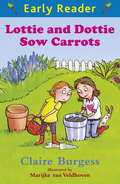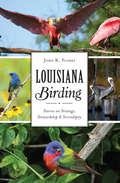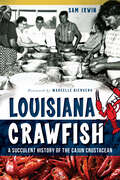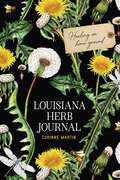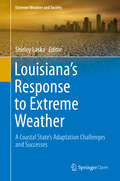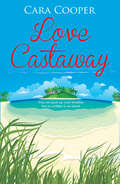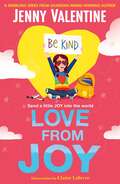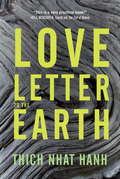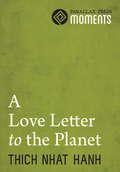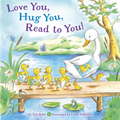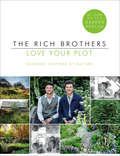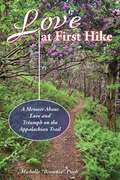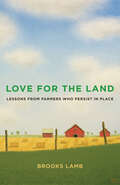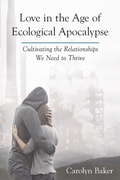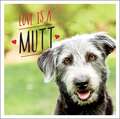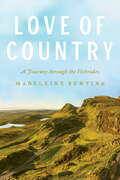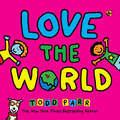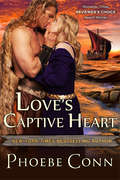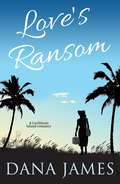- Table View
- List View
Lottie and Dottie Grow Pumpkins (Early Reader)
by Claire BurgessA brand new blue Early Reader about two little girls who love gardening, with tips on growing your own pumpkins in time for Halloween from one of the UK's top gardening bloggers.Early Readers are stepping stones from picture books to reading books, perfect for building confidence in new readers and reluctant readers. A blue Early Reader is perfect for sharing and reading together. A red Early Reader is the next step on your reading journey.Halloween is coming and Lottie and Dottie are growing their very own pumpkins. From making yummy soup to carving scary faces, there are lots of things for them to make and do.Perfect for budding gardeners. Contains instructions on how to grow your own pumpkins.
Lottie and Dottie Sow Carrots (Early Reader)
by Claire BurgessEarly Readers are stepping stones from picture books to reading books. A blue Early Reader is perfect for sharing and reading together. A red Early Reader is the next step on your reading journey.Lottie and Dottie love growing things and when they take a trip to Mr McWelly's Garden Centre they make the amazing discovery that carrots taste much better when they grow them themselves...
Louisiana Birding: Stories on Strategy, Stewardship & Serendipity (Natural History)
by John K. FloresFrom the bayous of the coast to prairies and rolling hills, Louisiana is home to a vibrant and thriving avian population. Herons, American goldfinches, snow geese and more call the state coastline home during the winter months. The music of neotropic songbirds like the parula and the prothonotary warbler fills the bayous every spring morning. Endangered species like the whooping crane and brown pelican have been reintroduced to the state to great success. The pragmatic conservation efforts of state, federal and private agencies not only led to the successful delisting of some endangered species of birds but also helped develop protocols for the future stewardship of others. Award-winning outdoor writer and photographer John Flores celebrates Louisiana's notable feathered inhabitants in their natural habitats.
Louisiana Crawfish: A Succulent History of the Cajun Crustacean (American Palate)
by Sam IrwinThe hunt for red crawfish is the thing, the raison d'etre, of Acadian spring. Introduced to Louisiana by the swamp dwellers of the Atchafalaya Basin, the crawfish is a regional favorite that has spurred a $210 million industry. Whole families work at the same fisheries, and annual crawfish festivals dominate the social calendar. More importantly, no matter the occasion, folks take their boils seriously: they'll endure line cutters, heat and humidity, mosquitoes and high gas prices to procure crawfish for their families' annual backyard boils or their corporate picnics. Join author Sam Irwin as he tells the story--complete with recipes and tall tales--of Louisiana's favorite crustacean: the crawfish.
Louisiana Herb Journal: Healing on Home Ground
by Corinne MartinIn a world of constant change and crisis, the relationship between humans and their environment has never been more vital. Louisiana Herb Journal invites readers into the world of medicinal herbs, introducing fifty herbs found in Louisiana, with details on identification, habitat, distribution, healing properties, and traditional uses, including instruction on popular preparation methods such as tinctures and teas. Interspersed with these practical details, herbalist Corinne Martin shares stories that foster a true connection between readers and the world around them, from tales of childhood cherry picking to harvest mishaps to folklife traditions passed down through the generations. Accessible to experienced and rookie herbalists alike, Louisiana Herb Journal offers a new way of looking at the natural world, getting to know one’s “home ground” through a lens of healing and participation.Family connections, an intimate knowledge of the surrounding lands and waters, strong community bonds, an irrepressible resilience, and a great capacity for celebrating life despite hardships are part and parcel of what it means to be from Louisiana. A celebration of the state and the cultures of those who live there, Louisiana Herb Journal reflects on the value of medicinal herbs in promoting personal healing and addressing current challenges to the state’s environmental and economic stability. Readers will gain a deeper recognition of the natural wealth Louisiana enjoys and the ways that our stewardship of wild plants can impact our personal health as well as the state’s ecological future.
Louisiana's Response to Extreme Weather: A Coastal State's Adaptation Challenges and Successes (Extreme Weather and Society)
by Shirley LaskaThis book is open access under a CC BY 4.0 license.This book takes an in-depth look at Louisiana as a state which is ahead of the curve in terms of extreme weather events, both in frequency and magnitude, and in its responses to these challenges including recovery and enhancement of resiliency.Louisiana faced a major tropical catastrophe in the 21st century, and experiences the fastest rising sea level. Weather specialists, including those concentrating on sea level rise acknowledge that what the state of Louisiana experiences is likely to happen to many more, and not necessarily restricted to coastal states. This book asks and attempts to answer what Louisiana public officials, scientists/engineers, and those from outside of the state who have been called in to help, have done to achieve resilient recovery. How well have these efforts fared to achieve their goals? What might these efforts offer as lessons for those states that will be likely to experience enhanced extreme weather? Can the challenges of inequality be truly addressed in recovery and resilience? How can the study of the Louisiana response as a case be blended with findings from later disasters such as New York/New Jersey (Hurricane Sandy) and more recent ones to improve understanding as well as best adaptation applications – federal, state and local?
Love Castaway
by Cara CooperDr Nancy Taylor, is contented with her lone conservationist role on a desert island. When Gareth Marrs lands his plane she wants him out of there. She craves isolation from the real world where she made a mistake so awful she cannot bear to return.Owner of a luxury cruise line, Gareth plans to profit from her precious hideaway. He is less than honest with Nancy about his reasons for being there. When the island is attacked by Somalian pirates, Gareth not only protects Nancy but begins to understand why she has shut herself away. He is deeply attracted to the beautiful enigmatic scientist, so different from the shallow conquests in his city home. When he awakens the emotions she has hidden for so long, Gareth offers a chance of happiness. But Nancy discovers his real reason for invading her hidden paradise, incensed, she orders him out of her life forever. Gareth isn’t a man so easily brushed off. Besides he knows the only future he can contemplate lies with her if only he can get her to face up to her demons.
Love Castaway
by Cara CooperDr Nancy Taylor, is contented with her lone conservationist role on a desert island. When Gareth Marrs lands his plane she wants him out of there. She craves isolation from the real world where she made a mistake so awful she cannot bear to return.Owner of a luxury cruise line, Gareth plans to profit from her precious hideaway. He is less than honest with Nancy about his reasons for being there. When the island is attacked by Somalian pirates, Gareth not only protects Nancy but begins to understand why she has shut herself away. He is deeply attracted to the beautiful enigmatic scientist, so different from the shallow conquests in his city home. When he awakens the emotions she has hidden for so long, Gareth offers a chance of happiness. But Nancy discovers his real reason for invading her hidden paradise, incensed, she orders him out of her life forever. Gareth isn’t a man so easily brushed off. Besides he knows the only future he can contemplate lies with her if only he can get her to face up to her demons.
Love From Joy (A Girl Called Joy #2)
by Jenny ValentineFor readers aged 9+ comes the second book in a sparkling new series about family, friends and finding the joy in life! From the mind of Guardian award-winning author Jenny Valentine, this is the perfect series for fans of Jacqueline Wilson, Cath Howe and Lara Williamson! Hi! My name is Joy Applebloom and I'm ten years old. People say I am a &‘glass half full&’ kind of person, which basically means I see the good in everything. And right now I&’m going to need all my powers of positive thinking to fix a really tricky situation . . . My new best friend Benny just hasn&’t been himself lately. I have to find out what&’s going on and bring back Benny&’s special smile for good…A heart-warming and positive story about family, friends and the importance of kindness with gorgeous illustrations from Claire Lefevre. Praise for A Girl Called Joy:'This book [. . .] is a delight for its warmth and humour, but principally because the writing is alive and stunning.&’ The Sunday Times Children's Book of the Week.
Love Immortal: Antique Photographs and Stories of Dogs and Their People
by Anthony CavoAn artfully designed compendium of 200 antiquarian photographs, all published here for the first time—including daguerrotypes, ambrotypes, tintypes, cartes de visite, and sepia and black-and-white images—culled from the private collection of longtime antiques collector, dealer, and appraiser Anthony Cavo, accompanied by an entertaining mix of historical anecdotes, true stories, excerpts from literature, letters, quotes, and fun facts.“Until one has loved an animal, a part of one’s soul remains unawakened.”—Anatole FranceDogs have been beloved companions since the dawn of humankind. With the advent of photography in the nineteenth century, this love was immortalized for the first time on film. While the clothing and the hairstyles of yesteryear may be very different—and intriguing to the modern eye—in these photos, the evident love between pet and owner is unmistakable, and remains as poignant today as when these images were taken. An avid collector of nineteenth- and early twentieth-century photographs for more than fifty years, Anthony Cavo has amassed an enormous catalog of antique photography, including hundreds of shots of people and their dogs. From this huge array, he has carefully curated 200 extraordinary pictures. These photos were taken from approximately 1840 to 1930 and offer a wide display of both candid and formal studio poses. Cavo arranges his subjects thematically and combines different photographic formats and images from different eras to create visual interest—whether the mix features a particular breed, a selection of images in shadow, or two images identical in pose but taken decades apart or in vastly different locations.In his introduction, Cavo offers a personal overview of this incredible treasury, which provides background on his lifelong experience as a collector and dog lover as well as touches briefly on photography’s birth and various forms in its earliest years. Hehas gathered not only a fascinating array of facts, history, quotes, and anecdotes about dogs which he sprinkles among these charming and fascinating photographs, but enhances the viewing experience for the reader through pointing out details, such as style trends, that help identify when an image was taken Here, too, are delightful anecdotes, from kidnapped pups who escaped and found their way home to devoted dogs who saved their owners’ lives. Cavo offers fun insights into the history of our association with pets, information on a range of breeds, and tips about animal care throughout the ages. Here are touching true stories, quotes from famous historical figures, and a cornucopia of miscellaneous trivia, such as: a dog’s presence in a household helps build immunity from disease in childrenDalmatians are born without their spots the canine is a powerful feng shui symbol of protection and justiceit’s good luck to have a stray follow you homea dog’s nose prints are as unique as a human’s fingerprintsand much moreThe ultimate companion book on humans’ favorite animal companion, Love Immortal is essential for all devoted to dogs, animal lovers, those with an interest in photography , and miscellany buffs.
Love Letter to the Earth
by Thich Nhat HanhWhile many experts point to the enormous complexity in addressing issues ranging from the destruction of ecosystems to the loss of millions of species, Thich Nhat Hanh identifies one key issue as having the potential to create a tipping point.<P> He believes that we need to move beyond the concept of the "environment," as it leads people to experience themselves and Earth as two separate entities and to see the planet only in terms of what it can do for them. Thich Nhat Hanh points to the lack of meaning and connection in peoples' lives as being the cause of our addiction to consumerism. He deems it vital that we recognize and respond to the stress we are putting on the Earth if civilization is to survive. Rejecting the conventional economic approach, Nhat Hanh shows that mindfulness and a spiritual revolution are needed to protect nature and limit climate change. Love Letter to the Earth is a hopeful book that gives us a path to follow by showing that change is possible only with the recognition that people and the planet are ultimately one and the same.
Love Letter to the Planet
by Thich Nhat Hanh<A Love Letter to the Planet is part of the Parallax Press Moments series of short ebooks. It is a passionate appeal from Zen Master Thich Nhat Hanh for ecological mindfulness and strengthening our relationship to the Earth.
Love You, Hug You, Read to You!
by Tish Rabe"There are three things I'll always do . . . love you, hug you, read to you!" The simple promise of togetherness offered in this bilingual (Spanish and English) board book is enhanced by interactive prompts throughout, encouraging parents to engage with their child while reading. Studies show that asking questions, like the ones in this book, helps children learn to read faster than if they just listen to a story. Love and literacy are gifts we can give to our children every day!From the Board edition.
Love Your Plot: Gardens Inspired by Nature: tips and tricks to transform your garden into a perfect paradise
by David Rich Harry RichA full-colour and beautifully illustrated guide into transforming your existing garden or plot of land into a modern, visually-stunning - but also easily achieved and maintained - space. Including full-colour images and tips and tricks from gardening experts and Chelsea Flower Show Gold Medal winners Harry and David Rich as well as suggestions tailored to various garden types, this is a must-read for anyone wanting that little bit of paradise to escape to at home...'Full of creativity and good ideas... plenty here to whet the appetite of an aspiring garden designer' -- Gardens Illustrated'Love Your Plot is a book to read right through and then dip into again to bring a particular idea or method of working back into focus.' -- Garden Design Journal'Very inspiring' -- ***** Reader review'This book is a joy to own, beautifully written and illustrated. It's crammed with information, easy to read and fantastic inspiration' -- ***** Reader review'Awesome book. Clear and easy to understand with lots of useful tips' -- ***** Reader review'Best book ever for any garden designer - an excellent read' -- ***** Reader review'A gold mine of garden design wisdom' -- ***** Reader review*****************************************************************************************************Fusing conceptual garden design with the beauty of the natural landscape, twice Chelsea Flower Show Gold Medal winners and stars of BBC's Garden Rescue Harry and David Rich are here to show you how you can transform your outdoor space into a beautiful Eden, no matter what plot you have.In Love Your Plot Harry and David set out to help you transform your outdoor space into an inspiration green haven by making nature work for you. Fusing different outdoor elements, such as coastal and woodland landscapes, alongside key design principles, they will show you how to create a modern, practical and visually stunning outdoor space that will awe and inspire - and that is crucially easy to maintain.Complete with practical tips, unique sketches and designs, planting suggestions and stunning full-colour visuals, Love Your Plot will have you reaching for the spade and wellies in no time at all to create your own Eden, no matter what plot you've got.
Love at First Hike
by Michelle PughWhen recent graduate Michelle Pugh sets out to fulfill a childhood dream of hiking the A.T. from start to finish, she enjoys the bliss of being surrounded by nature, the peacefulness of small trail towns, and the companionship of fellow hikers.
Love for the Land: Lessons from Farmers Who Persist in Place (Yale Agrarian Studies Series)
by Brooks LambA moving exploration of presence and place told through the stories of small-scale farmers who, despite intense adversity, continue caring for their land Love for the Land explores the power and potential of people-place relationships. Through clear and compelling prose, it elevates the virtues of imagination, affection, and fidelity—concepts promoted by farmer-writer Wendell Berry—and shows how they motivate small- and mid-scale farmers to care for the land, even in the face of adversity. Paying particular attention to farmland loss from suburban sprawl, rampant agricultural consolidation, and, for farmers of color, racial injustice, Brooks Lamb reckons with the harsh realities that these farmers face. Drawing from in-depth interviews and hands-on experiences in two changing rural communities, he shares stories and sacrifices from dozens of farmers, local leaders, agricultural service providers, and land conservationists. Lamb&’s rural roots and farming background enable him to cultivate honest, trusting connections with the farmers he engages, yielding raw and powerful insights. Time and again, compelling evidence reveals that stewardship virtues encourage people to live and act as devoted caretakers. With a refreshing, accessible, and engaging approach, Lamb argues that these resilient and often overlooked farmers show rural and urban people alike a way forward, one that serves people, places, and the planet. That path is rooted in love for the land.
Love in the Age of Ecological Apocalypse
by Carolyn BakerGiven the daunting, dire predicament in which we find ourselves on this planet, what is described by social critic James Howard Kunstler as a "Long Emergency" may in fact become a "Last Emergency" for humanity. Whether we encounter a "long" or a "last" emergency, Carolyn Baker seeks to offer inspiration and guidance for inhabiting our remaining days with passion, vitality, empathy, intimate contact with our emotions, kindness in our relationships with all species, gratitude, open-hearted receptivity, exquisite creations of beauty, and utilizing every occasion, even our demise, as an opportunity to invoke and "inflict" joy in our world. Love in the Age of Ecological Apolcalypse addresses an array of relationships in the Last Emergency and how one's relationship with oneself may enrich or impede interactions with all other beings.Drawing upon her deep experience as a life coach, Baker writes of the specific need to understand our key relationships in a society in collapse, and how to navigate through differing levels of acceptance of collapse, trauma, and grief. Key relationships include those with our partners, children, friends, neighbors, as well as relationships with our work, our bodies, our natural resources, food and eating, animals, future generations, Eros, and indeed, the powers of the universe. Baker's writing is engaging, inspiring, and often beautiful in its depth and candor. She introduces a variety of spiritual practices facilitate our developing a relationship with the deeper Self. With these practices and giving and receiving support from others who are walking a similar path, we begin to live more frequently from the deeper Self, or at least are able to access it more quickly when we find ourselves becoming embroiled in the ego.Table Of Contents * Introduction * Chapter 1: Living, Loving, and Preparing With A Reluctant Partner * Chapter 2: Children And Collapse * Chapter 3: Friends, Neighbors, and The Community * Chapter 4: Work and The Creative Soul * Chapter 5: Our Relationship With Resources * Chapter 6: Loving The Body As The World Falls Apart * Chapter 7: Our Relationship With Food: Mindful Eating As A Spiritual Practice * Chapter 8: Loving The Time Of Your Life * Chapter 9: What An Animal You Are! * Chapter 10: Darkness Matters * Chapter 11: Ensconsed In Eros, Bathed In Beauty * Chapter 12: Our Relationship With The Powers of The Universe * Chapter 13: Near-Term Extinction And Waking Up To Death * Chapter 14: Empire, I Wish I Knew How To Quit You * Chapter 15: Grief And Love In A Culture Of Congestive Heart Failure * Chapter 16: Our Relationship With Future GenerationsFrom the Trade Paperback edition.
Love is a Cockapoo: A Dog-Tastic Celebration of the World's Cutest Breed
by Charlie EllisCockapoos are loyal, loving and intelligent, and they look just like teddy bears – what more could you want from a pup? What they lack in size, they make up for in curliness and cuddliness. Dedicated to the world’s favourite hybrid, this paw-some book will prove that it’s not just any old dog that’s man’s best friend – it’s a cockapoo.
Love is a Mutt: A Dog-Tastic Celebration of the World's Cutest Mixed and Cross Breeds
by Charlie EllisLife is better with a muttThis collection of adorable photos of mongrels, mutts and crossbreeds will have you head-over-paws in loveThe dogs within these pages may be a mix of breeds, but they’re pure of heart. Some are fluffy. Some are scruffy. Some are wire-haired. Some have velveteen fur or shiny locks. Whatever they look like, big or small, they’re almost definitely lovable, mischievous and full of joy.This little book is a celebration of crossbreeds and mutts the world over. What mongrels lack in pedigree they more than make up for in cuteness, loyalty and love. Whether you’ve got one, want one or just think they’re super-cute, these adorable pups are here to win your heart. Love is a Mutt will prove that home is where your pup is, and that it’s not just any old dog who deserves to be your best friend – it’s a mongrel.
Love is a Mutt: A Dog-Tastic Celebration of the World's Cutest Mixed and Cross Breeds
by Charlie EllisLife is better with a muttThis collection of adorable photos of mongrels, mutts and crossbreeds will have you head-over-paws in loveThe dogs within these pages may be a mix of breeds, but they’re pure of heart. Some are fluffy. Some are scruffy. Some are wire-haired. Some have velveteen fur or shiny locks. Whatever they look like, big or small, they’re almost definitely lovable, mischievous and full of joy.This little book is a celebration of crossbreeds and mutts the world over. What mongrels lack in pedigree they more than make up for in cuteness, loyalty and love. Whether you’ve got one, want one or just think they’re super-cute, these adorable pups are here to win your heart. Love is a Mutt will prove that home is where your pup is, and that it’s not just any old dog who deserves to be your best friend – it’s a mongrel.
Love is a Spaniel: A Dog-Tastic Celebration of the World’s Most Lovable Breed
by Charlie EllisLife is better with a spanielThis paw-some collection of delightful photos and wise words will have you swooning for spanielsWith their irresistible smiles, ears for years and endless amounts of energy, it’s no wonder spaniels are one of the world’s favourite dog breeds. Featuring the English cocker, Welsh springer, Cavalier King Charles and all spaniels in between, this little book is a celebration of the spaniel’s happy personality and majestic attitude. Whichever type is your favourite, these clever canines are always ready to demonstrate their love and loyalty.Our fondness for these pooches spans the globe, and whether you have a spaniel of your own or just think they’re the best pups in town, the adorable doggos in these pages will melt your heart and leave you feeling warm and fuzzy. This paw-some little book will prove that it’s not just any old dog who deserves to be your best friend – it’s a spaniel.
Love of Country: A Journey through the Hebrides
by Madeleine Bunting&“Excellent . . . Almost the perfect marriage of travelogue to the inner landscape of political ideas and cultural reflections . . . a super read.&” —New Statesman Few landscapes are as striking as that of the Hebrides, the hundreds of small islands that speckle the waters off Scotland&’s northwest coast. The jagged, rocky cliffs and roiling waves serve as a reminder of the islands&’ dramatic geological history. Facing the Atlantic, the Hebrides were at the center of ancient shipping routes and have a remarkable cultural history. After years of hearing about Scotland as a place interwoven with the story of her family, Madeleine Bunting went to see for herself this place so full of history. Over six years, Bunting returned again and again to the Hebrides, fascinated by the question of what it means to belong there. With great sensitivity, she takes readers through the Hebrides&’ history of dispossession and displacement, a history that can be understand only in the context of Britain&’s imperial past, and she shows how the Hebrides have been repeatedly used to define and imagine Britain.Love of Country is a revelatory journey through one of the world&’s most remote, beautiful landscapes that encourages us to think of the many identities we wear as we walk our paths. &“A remarkably thorough digest of the many histories of the Hebrides.&” —Wall Street Journal &“Moving and wonderful. . . . Both the author and reader of this book end up losing themselves not just in politics and history and the details of nature, but a sense of wonder&” —The Guardian &“Makes you feel you are there even if you have just left.&” —Observer, Best Books of the Year
Love the World
by Todd ParrA celebration of love, respect, peace, and unity by bestselling author and illustrator Todd Parr.Love your grin. Love your skin. Love the bees. Love the trees.Love giving a hand. Love taking a stand.LOVE YOURSELF. LOVE THE WORLD!What the world needs now is love--and who better than Todd Parr to share a message of kindness, charity, and acceptance. Touching upon themes including self-esteem, environmentalism, and respect for others, Todd uses his signature silly and accessible style to encourage readers to show love for themselves and all the people, places, and things they encounter.
Love's Captive Heart: Author's Cut Edition
by Phoebe ConnEnslaved Handmaiden Finds Love and Freedom in the Viking Warrior Adventure Love's Captive Heart by Phoebe Conn920(AD), Land of the DanesThough she is the beloved handmaiden of Viking lord Raktor's spoiled daughter, Celiese d'Loganville is a slave in a gilded cage. When her mistress refuses to wed a man rumored to be horribly disfigured, Celiese seizes her chance for freedom—maybe even love.Mylan Vandahl has no need of a wife who pities him. But the enchanting—and perplexing—young woman, who fears him and boldly ignores his scars, arouses a need to soothe and tenderly seduce.But after a wedding night of unparalleled passion, the rising dawn reveals Celeise's treachery. Now in the fight of her life, for her dream of home and family, Celeise must find a way to heal Mylan's shattered trust.Other books by Phoebe ConnSavage DestinyDefiant DestinyForbidden DestinyWild DestinyScarlet Destiny
Love's Ransom
by Dana JamesZanthi normally enjoys her diplomatic work as Assistant Secretary at Jumelle's Government House. But strange events on the Caribbean island are troubling her. The unexpected arrival of land surveyor Garran Crossley only adds to the puzzle. Zanthi's hard-won calm is shattered when he announces she will be travelling with him to the jungle interior. Despite his blunt outspoken manner she senses there is much he isn't telling her. Can she trust the deepening attraction between them? Trust him?

